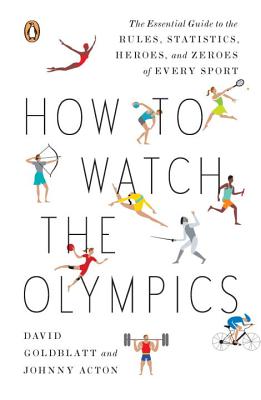In one sense, it's easy to figure out how to watch the Olympics: find a TV station that has the broadcast rights or stream it online, and you're watching the Olympics. But what exactly are you watching? How does one score points in a judo match? What's the difference between kayaking, canoeing, and rowing? What are the events that make up the decathlon? What about the heptathlon? What makes the modern pentathlon so modern? And what exactly is a repechage? With chapters for each of the sports (as well as the opening and closing ceremonies, medal ceremonies, past Olympic games, and discontinued Olympic sports), How to Watch the Olympics aims to be your go-to reference book during the 2012 London Olympic Games.
As a big fan of the Olympics, the cover of this book caught my eye as I was browsing in an airport bookstore. I initially hoped that it would be a critical socio-political at the games (with possible topics including American broadcasting strategy, the amount of money spent on the games, gender equality and inequality). Instead, though, it was a history-slash-introduction of the games and the sports on display, something I was also interested in checking out. As a young girl I latched onto a copy of one of David Wallechinsky's Complete Book of the Olympics and read it over and over until the pages started falling out. That was almost twenty years ago, though, and as I often feel with reference books, I wondered about its use in a world where so much information is available online; as I sat on my couch with my iPhone and this book, how many times would I reach for each one? I didn't keep track, but there have been times where I was reaching for the book (particularly during the cycling events). While I do think that this book would only be enhanced in some kind of ebook form that would allow links to video footage, maps, and more photographs, it can easily stand without these things (and, in fact, has to - it's very clear that this is an "unofficial" Olympic book and as such does not have any pictures of the Olympic rings, flames, or mascots). The intended audience is the average Olympic watcher - someone who might know something about a few of the sports but has little knowledge of others. It strikes a tone somewhere between chatty and instructional (and uses a lot of British expressions along the way). It could be read through from beginning to end, but also works if you want to pick it up and dip into sections as needed. I'd really love to see a companion version for the Winter Olympics as well as updated versions for future Games.
Find it at IndieBound.
Read it with:
The Complete Book of the Olympics 2012 Edition by David Wallechinsky and Jaime Loucky
The Ball is Round: A Global History of Soccer by David Goldblatt
Gold by Chris Cleave
Inside the Olympics by Nick Hunter

No comments:
Post a Comment